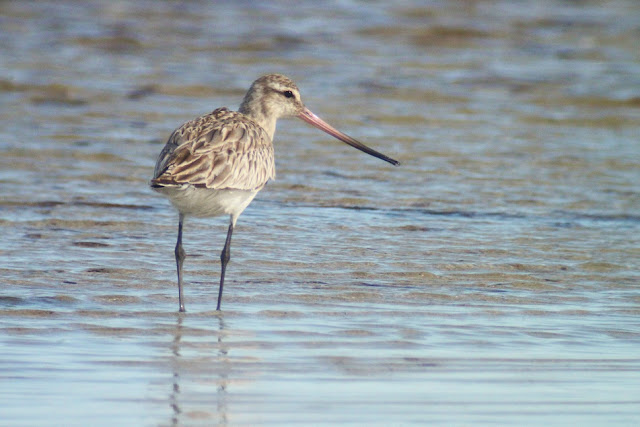A miserable, dark and wet morning turned golden when I spied a small group of medium-sized waders feeding just offshore at Port Prime. The 'Prime' ain't usually such a great spot for birding as one's morning solitude can be shattered in an instant as caterwauling two-stroke trailbikes and single cylinder thumpers tear (illegally) across the claypans just east of the coast and a mere 100 metres or so from the fertile feeding grounds of this tidal beach. Despite this, I thought I'd pull in for a quick scout & count when I happened upon a small group of Bar-tailed Godwit feeding on a falling tide.
In 2007 a flock of Bar-tailed Godwit were tagged in New Zealand and then tracked on their migratory journey toward China. On route to China, one female that was tagged within that original flock, made a brief stop-over on the feeding grounds on the Yellow Sea before heading onward to Alaska. After reaching Alaska and staying there for the breeding season, she then departed Alaska on a non-stop flight from Western Alaska to New Zealand. This flight set a new known flight record of 11,680 kilometres.
To quietly watch these birds feed is also an amazing sight. They feed with rapid, precise jabs deep into the soft mud of the inter-tidal areas of our beaches. Beneath this layer of incredibly sticky mud lay a treasure trove of molluscs , worms and small crustaceans. The tip of a Godwits' bill is sensitive and can detect minute movements within the murky depths of the mud, over the course of a feeding and 'fattening' season the tip of the bill of many birds shows signs of wear; as they are steadily ground down over months of continuous feeding.
This species, as well as many other migratory waders, face enormous pressures as they continue to struggle to find space, resources and sanctuary today. Here in Australia, many of our 'recreational' pursuits, such a fishing, crabbing, driving on beaches (???) and the walking of dogs 'off of the leash', are potentially threatening to the flocks of waders that rely on our tidal mudflats for survival. The ability to feed undisturbed is critical to species, such as Bar-tailed Godwit, in making a successful return flight to their breeding grounds in Scandinavia, Alaska and Northern Asia. Bar-tailed Godwits have been known to double their body weight in the final month of feeding before departing Australian shores to begin their continuous northward flight.
I feel that if many Australian beach users were educated about the many other pressures faced by these birds in areas, such as the Yellow Sea in China, perhaps we could find it in our hearts to give them a little more space and respect their right to continue to feed and roost without disturbance as they have done for many, many years.
Viva La Barwit.







No comments:
Post a Comment